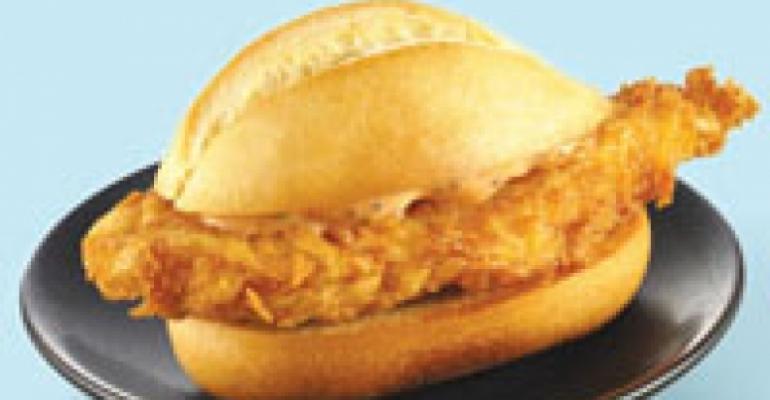Something totally unexpected occurred when Zaxby’s, a chain specializing in chicken fingers and Buffalo wings, offered a new product for free on July 7: Sales rose 5 percent compared with that same day a year earlier.
Zaxby’s wasn’t counting on an instant sales boost. Its plan was merely to get customers into restaurants to try the Nibbler, the chain’s first snack product, to see whether it could compete against rivals’ comparable products.
“The goal was to drive new interest,” said Jenifer Harmon, vice president and account group director for St. John & Partners, Zaxby’s ad agency, which created the giveaway promotion. “What in fact happened was we increased traffic across the board. The [promotional] buzz for one little, tiny sandwich drove so much incremental sales and interest in the brand.”
That effectively sums up why more chains are giving away menu items: Enticed by a freebie, customers will come in and buy other products, and if they’re new customers they’ll come back for more.
This growing marketing tactic goes beyond traditional buy-one-get-one-free offers, which operators and marketing experts agree can erode a brand’s value. Customers did not have to make a purchase to get a free cup of Starbucks’ Pike Place Roast when the chain reintroduced the blend. Star-bucks is continuing coffee giveaways across the nation.
McDonald’s gave away free coffee when it introduced its premium-roast product. Jamba Juice offered free smoothies this spring, and A&W All American Food restaurants handed out free root beer floats in a one-day promotion last month. Domino’s Pizza will award $1,000 in gift certificates to the winner of its recently concluded “staycation” promotion, and Taco Bell gave away its new Frutista Freeze for a week to anyone who requested one.
There’s an urgency now to dangle a freebie in front of consumers, and the reason is clear.
“There’s nothing like a recession to keep people at home, so it takes something as drastic as the promise of free things to get those same people in their cars and out to eat,” said Tonya Hamilton, founder of Hamilton Strategic Marketing in Madison, Wis.
Zaxby’s had a different reason for its giveaway. The chain’s same-store sales have increased for three consecutive years, Harmon said, but consumers’ eating habits are changing and they’re looking for snacks. When Zaxby’s decided to offer the limited-time Nibbler, priced at $1.39, the best way to let consumers know about it was to give it away, Harmon said.
The Athens, Ga.-based chain with more than 435 units in 12 states, promoted the giveaway for a week with in-store material and online banner ads, which allowed customers to save the date of the giveaway to their Facebook or Microsoft Outlook accounts.
“What we found is that we got this incredible buzz going,” Harmon said.
Buzz is precisely what giveaways are supposed to generate to get consumers to try a brand for the first time or increase their visits, and Zaxby’s strong sales for the event is not unusual, said Tim Hackbardt, a former Taco Time and Del Taco marketing executive who founded White Barn Group, a strategic restaurant marketing and ad agency in San Juan Capistrano, Calif.
Consumers will buy additional menu items when they come in for their freebies, he said, and because the giveaway usually generates a lot of awareness for the brand, “you get spill-off into other dayparts” from consumers who aren’t looking for a deal but buy something because the brand is now in their consideration set.
Hackbardt recalled his first job in restaurant marketing, when he was hired by a Pizza Hut franchisee to promote a particular location.
“He told me his secret,” Hackbardt said. “‘You give away as much food as you want. If I don’t get food in [customers’] mouths, they won’t come back.”
Giveaways are not like discounting, he said, because customers understand that a freebie is a one-time deal.
Discounting, however, can condition consumers to buy only when a deal is offered and cheapens the brand, according to speakers at the Nasdaq Food and Restaurant Industry Forum, held June 30 in New York.
Discounting “cannot overtake your brand in the long term,” said Todd Townsend, chief marketing officer for Sonic Drive-In. Although there’s a need to provide a discounts, as Sonic does with its Happy Hour, he said restaurants have to be careful not to overdo it.
Kay O’Leary, chief financial officer at Caribou Coffee, echoed that concern: “Consumers get trained on discounting. Customers will learn to actually wait for that discount.”
Zaxby’s “is not a believer in discounts,” Harmon said. “You lower the value of the product. Free is a different thing.”
Harmon pointed to the success of Chick-fil-A’s First 100 Fans program, which awards a one-year supply of free food to the first 100 adults at grand openings. Chain president Dan Cathy said Chick-fil-A has given away more than $7 million in free food since the program began in 2003.
“Does it devalue the brand? Not at all,” Harmon said. “Their loyal fans are even more loyal.”
Giveaways are not a marketing tool used solely by large chains, however. Tampa, Fla.-based Evos, a six-unit quick-service chain that boasts health-oriented burgers, fries and shakes, opened a unit in Chapel Hill, N.C., earlier this month and celebrated the grand opening with a direct-mail campaign inviting 10,000 people to come in for a free meal.
Evos doesn’t discount its meals, but the chain does believe that a giveaway is important in generating brand awareness, said Bernie Hinson, area development representative for SKS Healthy Foods LLC, master developer and franchisee of Evos restaurants in metropolitan Atlanta and North Carolina.
“It’s an invitation to experience the brand,” he said. “We would just like people to try the food. We’re very proud of our products.”




